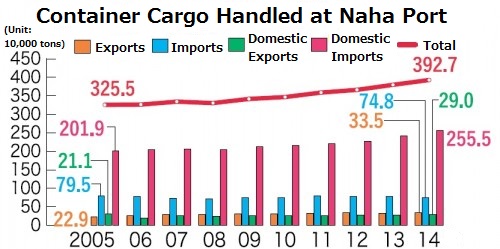Container cargo handled at Naha Port reaches record high of 3.92 million tons

August 20, 2015 Ryukyu Shimpo
According to a preliminary estimate from the 2014 Naha Port Statistics compiled by the Naha Port Administration Management Union and released on August 19, container cargo handled at Naha Port has reached a record high of 3.927 million tons, up 3.4 percent from the previous year. However, imports and exports from overseas were only 1.083 million tons, down 1.6 percent from the previous year. This is only one tenth of the official target determined by port planners.
Furthermore, cargo exported overseas and to other parts of Japan was only 624 thousand tons, while imported cargo, at 3.303 million tons, reached more than five times that amount. These numbers show an extreme imbalance towards imports.
In 2014, ships arriving at Naha Port increased by 4.9 percent to 7,905. The total tonnage of ships also increased by 13.8 percent to a total of 24.239 million tons. Cargo ships traveling an international route reached 327, a 16.4 percent increase, while domestic cargo ships numbered 2,401, a 3.4 percent decrease.
Domestic cargo coming from and going to other Japanese ports was a total of 2.844 million tons, a 5.4 percent increase from the previous year. Of this amount, exports made up 289,000 tons, a 4.9 percent increase, while imports made up 2.555 million tons, a 5.5 percent increase. Of the 1.083 million tons of cargo directly traded with other countries, exports marked a 2.9 percent increase, reaching 334 thousand tons, while imports marked a 3.6 percent decrease, falling to 748 thousand tons.
The official Naha Port Plan, updated in 2003, aspired to making Okinawa a transshipment hub through which goods from all over Asia would pass on their way to North America over the sea route. The plan aimed for the total quantity of international cargo passing through Naha Port to reach 10.2 million tons within ten years, by the mid-2010s.
However, competition due to the rapid increase in size of many of Asia’s ports has prevented Naha Port from functioning as a transshipment hub, and now, more than ten years after the drafting of the updated Port Plan, its goals have yet to be achieved. In fact, the total amount of direct overseas imports and exports to and from Okinawa and the total quantity of international cargo (including non-container cargo) handled in Okinawa remain only slightly over 1 million tons, a level one tenth of that put forth in the Plan.
Previous Article:Okinawa tourism and Culture Festa in Motobu
Next Article:Okinawa Prefectural Fisheries Cooperative leaders protest U.S. military helicopter crash
[Similar Articles]
- Naha Port records its highest container load handling volume
- Naha airport International cargo shipments amounts to over 180,000 tons
- Remnant of the U.S. occupation? Half of imported margarine goes to Okinawa
- Okinawan beer export reaches new record
- Okinawa tourist numbers break record, reaching about 8 million
 Webcam(Kokusai Street)
Webcam(Kokusai Street)


